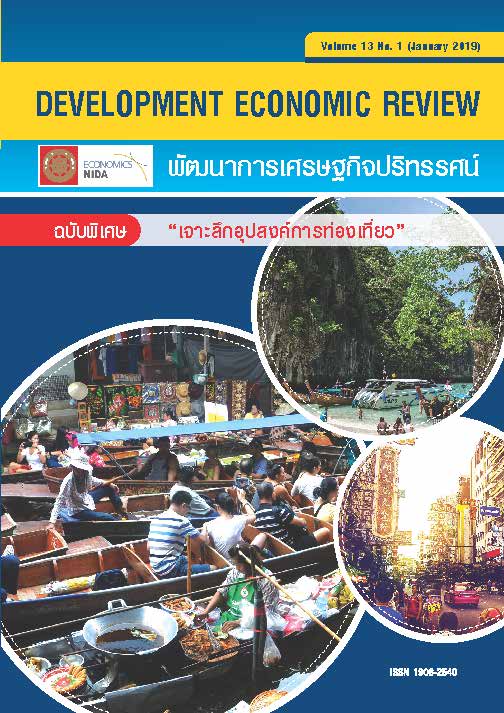Tourism Multiplier and Income Distribution: Empirical Evidences from Hotel-Level Data in Thailand
Main Article Content
Abstract
Tourism industry shows an important role for generating income, creating jobs, and linking to other related sectors. This research article, therefore, aims explaining impacts of tourism on income generating and income distribution in Thailand through the tourism multiplier mechanism. Using national-representative survey of hotel-level data in Thailand, our analysis indicates that the relationship between tourism multipliers and hotel earnings is found to be negative. This reflects that high-profit hotels may have a low income distribution. In addition, large hotels, having foreign investment, form of partnership, and public company are found to have negative impact on income distribution to labor. On the other hand, smaller hotels that provide Thai massage is found to be positively affect to increase distribution of income to the hotel’s workforces. Our results, therefore, support needs from government to promote capacity building of small and local hotel by creating linkages to community business in order to ensure that laborers in hotel industry will be able to reap more benefits from tourism sector.
Article Details
Copyright to published manuscripts becomes the property of the Graduate School of Development Economics, National Institute of Development Administration. Reproduction of all or part of a Development Economic Review (DER) article by anyone, excluding author(s), is prohibited, unless receiving our permission.
Disclaimer: Opinions expressed in articles published in this journal are those of the author (s) and do nto necessarily represent opinions of the Graduate School of Development Economics, National Institute of Development Administration. Trade and proprietary names are only for identification and not constitute our endorsement.
References
Băltescu, C. A., & Boşcor, D. (2014). the Assessment of Hotel Services in Poiana Braşov Resort. Bulletin of the Transilvania University of Braşov Series V: Economic Sciences @BULLET, 7(2).
Banerjee, O., & Cicowiez, M. (2015). A quantitative framework for assessing public investment in tourism e An application to Haiti *, 51.
Domínguez, J. M., & Pholphirul, P. (2018). Service Facilities and Hotel Performance : Empirical Evidence from Hotel-Level Data in Thailand. Development Economic Review, 12.
George, B. P., Miller, M. M., & Henthorne, T. L. (2008). The Competitiveness of the Cuban Tourism Industry in the Twenty-First Century : A Strategic Re-Evaluation. Journal of Travel Research, 46(February), 268–278.
Horwath Tourism and Leisure Consulting. (1981). Tourism Multipliers Explained. Conjunction with The World Tourism Organization.
Kim, H., & Kim, B.-G. (2015). Economic impacts of the hotel industry: an input-output analysis. Tourism Review, 70(2), 132–149.
Kim, J. (2004). Growth of regional economy and income inequality : county-level evidence from Florida , USA Growth of regional economy and income inequality : county-level evidence from. Applied Economics, 36(2).
Lacher, R. G., & Nepal, S. K. (2010). Dependency and development in northern Thailand. Annals of Tourism Research, 37(4), 947–968.
León-darder, F., Villar-garcía, C., & Pla-barber, J. (2011). Entry mode choice in the internationalisation of the hotel industry : a holistic approach, 2069. Mahadevan, R., Amir, H., & Nugroho, A. (2016). Regional impacts of tourism-led growth on poverty and income inequality: A dynamic general equilibrium analysis for IndonesiaTitle. Tourism Economics, 23(3), 614–631.
Mathieson, A., & Wall, G. (1983). Tourism: Economic, Physical, and Social Impacts. Journal of Travel Research, 22(1).
